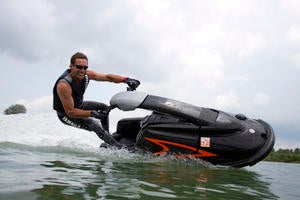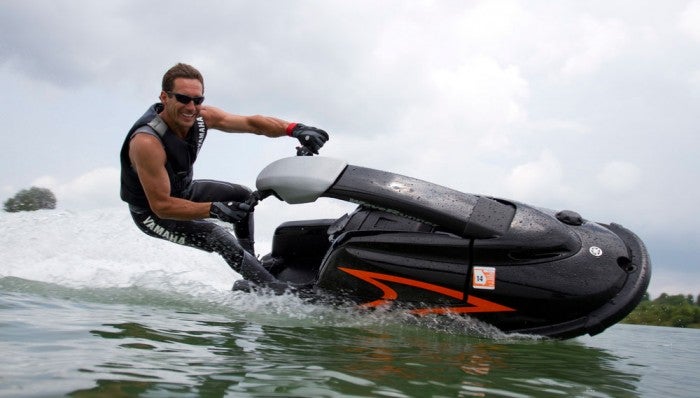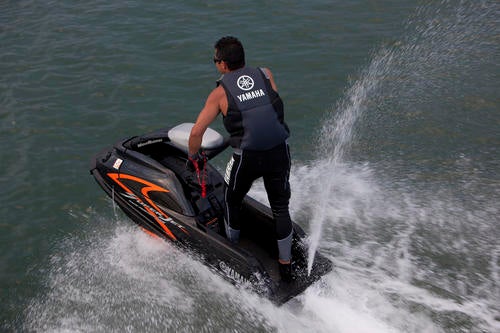2012 Yamaha SuperJet Review
Popular stand-up lives on in 2012...for racers only
To paraphrase several notable speeches, the reports of the Yamaha SuperJet’s death have been greatly exaggerated.
Well, at least kind of…
Yes, the SuperJet does live on in 2012, now dressed up in a bold new black-and-orange color scheme that’s far removed from the Yamaha Blue that has dominated in recent years. And yes, despite the craft’s two-stroke engine (one that no longer passes nationwide emissions standards), you can still buy one in the new year. That is, if you’re a racer. Though the mainstream public is out of luck, those with a race license — who use the craft strictly for racing purposes — can still purchase a ’12 model.
What will they get? A craft that is very much the same as the boat that could be purchased in 2011. And yes, a craft that is still one of the best standup machines ever produced.
 This 701cc two-stroke engine has enough oomph to stretch your arms when you squeeze the throttle.
This 701cc two-stroke engine has enough oomph to stretch your arms when you squeeze the throttle.The engine that has caused the craft’s mainstream demise remains the boat’s familiar 701cc two-stroke, a twin-cylinder design with dual 38mm Mikuni carbs that old-school fans have long celebrated. Linked to a 144mm jet pump, it powers the SuperJet out of the hole with enough force to stretch its pilot’s arms, pulls it out of the tightest turns with precision, and peaks in the neighborhood of 45 mph. Slow, you say? In actuality, that’s fairly fast on a standup. To go beyond those speeds takes some serious riding skills. Of course, this version is meant for racers, a group that already knows there are plenty of aftermarket mods on the market to make it go even faster.
Accessing that power is accomplished via a trigger-style throttle, linked to handlebars at the end of a pivoting handlepole. That handlepole is spring-loaded to take the strain off your back. The remaining contact point with the craft is the well-padded rider tray (racers will recognize the Hydro-Turf brand name), which in traditional SuperJet fashion features a small kick-step at the rear to provide added leverage. A handlebar adjustment is available to quicken up the craft’s steering if desired.
 Though it can reach top speeds of about 45 mph, the Super Jet really shines in the corners.
Though it can reach top speeds of about 45 mph, the Super Jet really shines in the corners.And let’s face it, who won’t want to exploit the hull’s strengths. Always a quick-responding craft, the boat’s reactions improved in 2008 with a few modifications to the running surface. The hull flares forward and slims aft, and features deep chines and a pump moved farther back, along with an extended rideplate. The design produces more wetted surface forward, and gives the boat the intuitive, inside-lean early models lacked. Like the Kawasaki Jet Ski before it, the design also aids those still in the learning process, giving the boat more stability.
Fun? I think the SuperJet still feels short and agile, a great boat for freestyle maneuvers, and yet carves up a buoy course with the precision and confidence of a bigger model. It’s definitely the best SuperJet design ever produced. One small downside is possibly a small loss in absolute top-speed stability, but that’s a tradeoff I think most riders will readily accept. Standups are most fun when they’re being turned and carved. They’re not straight-line drag racers.
My lasting impression of the SuperJet? Just plain, simple fun, and lots and lots of it. In fact, it might be worth becoming a racer…just to keep enjoying the ride.
| 2012 Yamaha SuperJet Specs | |
| Length | 88.2 inches |
| Beam | 26.8 inches |
| Dry Weight | 306 lbs |
| Engine | Twin cylinder, two-stroke |
| Displacement | 701 cc |
| Bore and Stroke | 81mm x 68 |
| Compression Ratio | 7.2:1 |
| Rated Horsepower | N/A |
| Fuel Capacity | 4.8 gal. |
| Colors | Eclipse Black |
| Price | $7,999 |
Related Reading
2011 Yamaha SuperJet Review
Stand-up PWC Lives on in 2012…Kind of
Stand-Up PWC May Be Reaching the End of an Era
How to Ride a Stand-up PWC
2012 Yamaha WaveRunner Lineup Preview [Video]
2012 Yamaha VX Sport Review
Get PersonalWatercraft.com in your Inbox!
Like PersonalWatercraft.com on Facebook
Comments
Most Popular

2025 Yamaha JetBlaster PRO 2-Up Review

2024 Kawasaki Jet Ski STX 160X Review

Remembering the Sea-Doo XP

Whatever Happened to the Wetbike?

2025 Yamaha JetBlaster Review
















 Your Privacy Choices
Your Privacy Choices